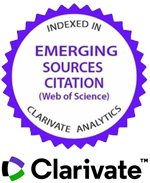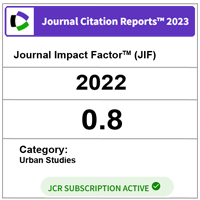BIM Backed Decision Support System in the Management of Heritage Building
DOI:
https://doi.org/10.11113/ijbes.v6.n2.357Keywords:
BIM, cultural heritage management, historic building, exploratory research, decision support systemAbstract
Historical buildings are always at risk to great danger strike by fire, flood and other potential disasters affecting the building conditions. Thus positive and continuous actions need to be taken to preserve the heritage buildings or else a country might lose its cultural heritage value. In managing historic buildings, managers are often faced with complex decision-making process due to limited or unavailability of reliable information. The absence of such information influenced the way decision making and problem-solving made by the managers. This paper aims to highlight the potentials of Building Information Modelling (BIM) as a decision support system for cultural heritage management. An embedded case study was conducted on Istana Balai Besar Kota Bharu, focusing on the changes of the historical building's layout to demonstrate the ontology. A measured drawing dated back in 1976 was used together with the terrestrial laser scanning activity performed presently on the physical building in creating a model in BIM environment. The result gives an overview about tracking information on changes within a historical building as part of cultural heritage management. This paper finds that by modelling the data captured by the 3D laser scanner and utilizing the existing data, BIM is capable of helping managers to retrieve, analyze and store important information in a more efficient and productive process. This exploration is substantial as a precursor to a much broader study on BIM for cultural heritage in the Malaysian context. As BIM is set to drive the construction industry, the finding made would be a catalyst for creating awareness to support the development of BIM for cultural heritage management in Malaysia.
References
Abdul Rashid, R., & Ahmad, A. G. (2011). Overview Of Maintenance Approaches Of Historical Buildings In Kuala Lumpur - A Current Practice. Procedia Engineering. 20: 425–434. https://doi.org/10.1016/j.proeng.2011.11.185
Abdul Shukor, S. A., Wong, R., Rushforth, E., Basah, S. N., & Zakaria, A. (2015). 3D Terrestrial Laser Scanner For Managing Existing Building. Jurnal Teknologi. 76(12): 133–139.https://doi.org/10.11113/jt.v76.5895
Allen W, Cruz J, Warburton B (2017) How Decision Support Systems can Benefit From A Theory Of Change Approach. Environmental Management, https://dx.doi.org/10.1007/s00267-017-0839-y
Ali, M., Ismail, K., Suhaimi, M.S, Hashim, K.S.H.Y, and Mustafa, M.H., (2018), Heritage Building Preservation through Building Information Modelling: Reviving Cultural Values through Level Of Development Exploration. Journal of the Malaysian Institute of Planners, Volume. 16(2): 62 -72. http://dx.doi.org/10.21837/pmjournal.v16.i6.461
Ali, M., Ismail, K., Hashim, K.S.H.Y, Suhaimi, M.S, and Mustafa, M.H., (2018), Historic Building Information Modelling (HBIM) For Malaysian Construction Industry. Journal of the Malaysian Institute of Planners. 16(3): 332 -343. http://dx.doi.org/10.21837/pmjournal.v16.i7.522
Alkan, R. M., & Karsidag, G. (2012). Analysis of The Accuracy of Terrestrial Laser Scanning Measurements. FIG Working Week 2012 - Knowing to Manage the Territory, Protect the Environment, Evaluate the Cultural Heritage, (May 2012), 16.
Baik, A., Alitany, A., Boehm, J., & Robson, S. (2014). Jeddah Historical Building Information Modelling "JHBIM"; Object Library. ISPRS Annals of Photogrammetry, Remote Sensing, and Spatial Information Sciences, II-5(May), 41–47. https://doi.org/10.5194/isprsannals-II-5-41-2014
Baxter, P., & Jack, S. (2008). Qualitative Case Study Methodology: Study Design and Implementation for Novice Researchers . The Qualitative Report. 13(4): 544-559. Retrieved from https://nsuworks.nova.edu/tqr/vol13/iss4/2
Bengtsson P. (1999), Multiple Case Studies- Not Just More Data Points?!. Term Paper In Graduate Course in Research Methodology, University of Karlskrona Ronneby. Spring 1999. doi=10.1.1.30.9769
Blinn, N., & Issa, R. R. A. (2017). Utilisation of Drawing Management Software To Enhance BIM Educational Experiences. BIM Academic Symposium. 0: 1–8.
Calin, M., Damian, G., Popescu, T., Manea, R., Erghelegiu, B., & Salagean, T. (2015). 3D Modeling for Digital Preservation of Romanian Heritage Monuments. Agriculture and Agricultural Science Procedia. 6: 421–428. https://doi.org/10.1016/j.aaspro.2015.08.111
Carbonari, G., Stravoravdis, S., & Gausden, C. (2015). Building Information Model Implementation For Existing Buildings For Facilities Management: A Framework And Two Case Studies. 149: 395–406. https://doi.org/10.2495/BIM150331
Cheong, Y. Y., & Nur Emma Mustaffa. (2017). Critical Success Factors for Malaysian Construction Projects: An Investigative Review. International Journal of Built Environment and Sustainability. 4(2): 93–104. https://doi.org/10.11113/ijbes.v4.n2.180
Eastman, C. Teicholz, P. Sacks, R., & Liston, K. (2008). BIM Handbook A Guide to Building Information Modeling for Owners, Managers, Designers, Engineers, and Contractors. John Wiley & Sons, Inc.
Eisenhardt, K. M., & Graebner, M. E. (2007). Theory Building From Cases: Opportunities and challenges. The Academy of Management Journal. 50(1): 25-32. https://doi.org/10.5465/amj.2007.24160888
Gaidytė, R. (2010). 2D and 3D Modeling Comparison, 1–38. Retrieved from http://brage.bibsys.no/hig/bitstream/URN:NBN:no-bibsys_brage_12669/1/Gaidyte,R..pdf
Hardin, B. (2009), BIM and Construction Management: Proven Tools, Methods and Workflows, Canada:Wiley Publishing Incorporated.
Harun, S. N. (2011). Heritage Building Conservation In Malaysia: Experience And Challenges. Procedia Engineering. 20: 41–53. https://doi.org/10.1016/j.proeng.2011.11.137
Ismail, S. A., Bandi, S., & Maaz, Z. N. (2018). An Appraisal into the Potential Application of Big Data in the Construction Industry. International Journal of Built Environment and Sustainability. 5(2): 145–154. https://doi.org/10.11113/ijbes.v5.n2.274
Jones C, Cowan P, Allen W (2012) Setting Outcomes, And Measuring And Reporting Performance Of Regional Council Pest And Weed Management Programmes. Landcare Research, Lincoln, New Zealand
Kidder, T. (1982). Soul of a New Machine. New York: Avon.
López, F., Lerones, P., Llamas, J., Gómez-García-Bermejo, J., & Zalama, E. (2018). A Review of Heritage Building Information Modeling (H-BIM). Multimodal Technologies and Interaction. 2(2): 21. https://doi.org/10.3390/mti2020021
K.B. Matthews, M. Rivington, K. Blackstock, G. McCrum, K. Buchan, and D.G. Miller. 2011. Raising the bar? - The Challenges Of Evaluating The Outcomes Of Environmental Modelling And Software. Environ. Model. Softw. 26(3) (March 2011): 247-257. DOI=http://dx.doi.org/10.1016/j.envsoft.2010.03.031
Maina, J. J. (2018). Barriers to effective use of CAD and BIM in Architecture Education in Nigeria. International Journal of Built Environment and Sustainability. 5(3): 175–186. https://doi.org/10.11113/ijbes.v5.n3.275
Mazzanti, Massimiliano, 2002. "Cultural Heritage As Multi-Dimensional, Multi-Value And Multi-Attribute Economic Good: Toward A New Framework For Economic Analysis And Valuation," Journal of Behavioral and Experimental Economics (formerly The Journal of Socio-Economics), Elsevier. 31(5): 529-558.
Mohamed Salleh, R., Mustaffa, N., Abdul Rahiman, N., Tajul Ariffin, H., & Othman, N. (2019). The Propensity of Building Information Modelling and Integrated Project Delivery in Building Construction Project. International Journal of Built Environment and Sustainability. 6(1-2): 83-90. https://doi.org/10.11113/ijbes.v6.n1-2.386
Mohd-Isa, A. F., Zainal-Abidin, Z., & Hashim, A. E. (2011). Built heritage maintenance: A Malaysian perspectives. Procedia Engineering. 20: 213–221. https://doi.org/10.1016/j.proeng.2011.11.158
Mohd Noor, N., Kamaruddin, Z., Abdullah, A., Abdullah, A.A., Eusoff, S.S. and Mustafa, M.H. (2018), “Using Terrestrial Laser Scanner For Malay Heritage Documentation: Preliminary Approach to Istana Balai Besar, Kelantan”, International Journal of Development and Sustainability. 7(6): 1886-1897.
Núñez Andrés, A., Buill Pozuelo, F., Regot Marimón, J., & de Mesa Gisbert, A. (2012). Generation of Virtual Models Of Cultural Heritage. Journal of Cultural Heritage. 13(1): 103–106. https://doi.org/10.1016/j.culher.2011.06.004
Oladotun, A. J., & Edosa, O. M. (2017). The Need for Professionalism and Competencies in the Construction Industry. International Journal of Built Environment and Sustainability. 4(1): 10–16. https://doi.org/10.11113/ijbes.v4.n1.154
Seghier, T. E., Lim, Y. W., Ahmad, M. H., & Samuel, W. O. (2017). Building Envelope Thermal Performance Assessment Using Visual Programming and BIM, based on ETTV requirement of Green Mark and GreenRE. International Journal of Built Environment and Sustainability. 4(3): 227–235. https://doi.org/10.11113/ijbes.v4.n3.216
Sodangi, M., Khamdi, M. F., Idrus, A., Hammad, D. B., & Ahmedumar, A. (2014). Best Practice Criteria For Sustainable Maintenance Management Of Heritage Buildings in Malaysia. Procedia Engineering. 77: 11–19. https://doi.org/10.1016/j.proeng.2014.07.017
Tripathi, K. P. (2011). Decision Support System Is a Tool for Making Better Decisions in the Organization. Indian Journal of Computer Science and Engineering. 2(1): 112–117.
Volk, R., Stengel, J., & Schultmann, F. (2014). Building Information Modeling (BIM) For Existing Buildings - Literature Review And Future Needs. Automation In Construction. 38(October 2017): 109–127. https://doi.org/10.1016/j.autcon.2013.10.023
Yusuf Arayici, (2008) "Towards Building Information Modelling For Existing Structures". Structural Survey. 26(3): 210-222, https://doi.org/10.1108/02630800810887108
Downloads
Published
How to Cite
Issue
Section
License
Copyright of articles that appear in International Journal of Built Environment and Sustainability belongs exclusively to Penerbit Universiti Teknologi Malaysia (Penerbit UTM Press). This copyright covers the rights to reproduce the article, including reprints, electronic reproductions or any other reproductions of similar nature.
Authors who publish with this journal agree to the following terms:
- This Journal applies Creative Commons Licenses of CC-BY-NC-SA
- Authors retain copyright and grant the journal right of publication with the work simultaneously licensed under a Creative Commons Attribution License that allows others to share the work with an acknowledgement of the work's authorship and publication in this journal.
- Authors are able to enter into separate, additional contractual arrangements for the non-exclusive distribution of the journal's published version of the work (e.g., post it to an institutional repository or publish it in a book), with an acknowledgement of its publication in this journal.
- Authors are permitted and encouraged to post their work online (e.g., in institutional repositories or on their website) prior to and during the submission process, as it can lead to productive exchanges, as well as earlier and greater citation of published work (See The Effect of Open Access).







